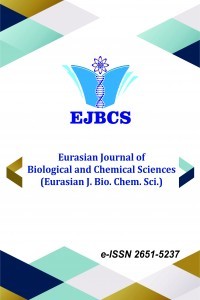Nanoteknoloji Uygulamalarında Hayatımıza Yansımalar
Nanoteknoloji, Nanoboyut, Nanotıp, Nano Uygulama, Nanoteknolojik Etki
Reflections to our Lives in Nanotechnology Applications
___
- Appenzeller T. 1991. The man who dared to think small. Sci. 254:1300
- Serena P. 2016. Guíaespecífica de trabajo sobre, nanotecnología para la revolución urbana: ciudades inteligentes.
- Özkaleli̇ M, Erdem A. 2016. Nano atıklar ve çevre: Atık yönetiminde yeni bir yaklaşım. Pamukkale Ü. Mühendislik Bilimleri Dergisi. 22(3):183-188
- Namlıgöz ES, Hoşaf E, Çoban S, Gülümser T, Tarakçıoğlu I. 2007. Su, Yağ ve Kir İticilik Bitim İşlemlerindeki Son Gelişmeler (Bölüm 2). Ege Ü. Tekst. Konfeksiyon Dergisi. 17(1):59-64
- Feynman RP. 1969. What is sci. The Physics Teacher. 7(6):313-320
- Maclurcan DC. 2005. Nanotechnology and Developing Countries, Part 1: What Possibilities, J. Nanotech.
- Luther W. 2004. Industrial application of nanomaterials - chancesand risks: Technology analysis. In W. Luther (Ed.), Future Techn. 54:1-119
- Rittner M. 2002. Market Analysis of Nanostructured Materials, March 2002. American Ceramic Society Bulletin. 81(3):33-36
- Martín-Gago JA, Casero E, Briones C, Serena PA. 2009. Nanociencia y Nanotecnología. Entre lacienciaficción del presente y la tecnología del futuro. Fundación Española para la Ciencia y la Tecnología FECYT, Madrid.
- Brainina Kh, Stozhko N, Bukharinova M, Vikulova E. 2018. Nanomaterials: Electrochemical Properties and Application in Sensors. Physical Sci Reviews, 3(9). doi: https://doi.org/10.1515/psr-2018-8050
- Deisingh AK, Wilson AG, Elie AG. 2009. Biochip Platforms for DNA Diagnostics. Microarrays pp 271-297
- Murali K, Neelakandan MS, Thomas S. 2018. Biomedical Applications of Gold Nanoparticles. JSM Nanotechnol Nanomed. 6(1):1064
- Santosh Bahadur S, Praveen Kumar T. 2014. Catalysis: A Brief Review on Nano-Catalyst. Journal of Energy and Chemical Engineering. 2(3):106-115
- Babatunde DE, Denwigwe IH, Babatunde OM, Agboola O, Akinsipe GD. 2019. Relevance of chemically functionalized nano-_llers and modi_ed nanocomposite in energy systems, in Polymer Nanocomposites for Advanced Engineering and Military Applications. Hershey, PA, USA: IGI Global Press.
- Mattmann C, Amft O, Harms H, Tröster G, Clemens F. 2007. In Recognizing upper body postures using textile strain sensors, Wearable Computers, 2007 11th IEEE Int. Symposium on. 29-36
- Yan J, Han L, Gao W, Xue S, Chen M. 2016. Biochar supported nanoscale zero valentiron compositeused as persulfate activator for removing trichloroethylene. Bioresour Techn. 175:269-274
- Patel V. 2012. "Elastomeric Nanocomposites: Tires Promoting Nanophiles Market Growth", Nanotech Insights. 3(4):44-48
- Green AC, Williams GM, Logan V, Strutton GM. 2011. Reduced melanoma after regular sunscreen use: randomized trial follow-up. J. Clin. Oncol. 29(3):257-263
- Gomes CSF, Silva JBP. 2007. Minerals and clay minerals in medical geology. Applied Clay Sci. 36:4-21
- Terry LA, White SF, Tigwell LJ. 2005. The application of biosensors to fresh produce and the wider food industry. J. Agricult. Food Chem. 53:1309-1316
- Thévenot DR, Toth K, Durst RA, Wilson GS. 2001. Electrochemical biosensors: recommended definitions and classification. Biosens. Bioelectron. 16: 21-31
- Chen M, Qin X, Zeng G. 2017. Biodegradation of carbon nanotubes,graphene and their derivatives, Trends Bio. 35: 836-846
- Saleh TA. 2016. Nanomaterials for pharmaceuticals determination. Bioenergetics, 5: 226.
- Süfer Ö, Karakaya S. 2011. Gıda Endüstrisi ve Nanoteknoloji: Durum Tespiti ve Gelecek, Akademik Gıda. 9(6):81-88
- Gupta R, Xie H. 2018. Nanoparticles in Daily Life: Applications, Toxicity and Regulations. Journal of Environmental Pathology, Toxicology and Oncol. 37(3):209-30
- Jain A, Ranjan S, Dasgupta N,Ramalingam C. 2018. Nanomaterials in Food and Agriculture: An Overview on Their Safety Concerns and Regulatory Issues. Critical Reviews in Food Science and Nutrition. 58(2):297-317
- Ahmadi MH, Ghazvini M, Alhuyi Nazari M, Ahmadi MA, Pourfayaz F, Lorenzini G, Ming T. 2019. Renewable energy harvesting with the application of nanotechnology: A review. Int J Renew Energy Res. 43:1387-1410
- Güzeloğlu E. 2015. Akıllı Ürünleriyle Nano Yeniliği: Gençlerin Nanoteknoloji Farkındalığı, Fayda/Risk Algıları. Int Journal of Human Sci. 12(1):274-297
- Gunasekera UA, Pankhurst QA, Douek M. 2009. Imaging applications of nanotechnology in cancer. Target Oncol. 4: 169-181
- Babatunde DE, Denwigwe IH, Babatunde OM, Gbadamosi SL, Babalola IP, Agboola O. 2020. Environmental and societal impact of nanotechnology. IEEE Access. 8:4640-4667
- Elmarzugi NA, Keleb EI, Mohamed AT, Benyones HM, Bendala NM, Mehemed AI, Eid AM. 2014. Awareness of Libyan Studentsand Academic Staff Members of Nanotechnology. J. Appl Pharm Sci. 4(6):110-114
- Süpüren G, Kanat ZE, Çay A, Kırcı T, Gülümser T, Tarakçıoğlu I. 2007. Ege Univ Tekst Konfeksiyon Dergisi. 17(1):15-17
- Ateş M, Osken I, Ozturk TJ. 2012. Journal of Electrochemical Science and Techn. 159(6):115-121
- Özdoğan E, Demir A, Seventekin N. 2006. Lotus Etkili Yüzeyler. Ege Ü. Tekst. Konfeksiyon Dergisi. 16(1):287-290
- Katz LM, Dewan K, Bronaugh RL. 2015. Nanotechnology in Cosmetics. Food and Chemical Toxicology. (85):127-37
- Faghihi K, Raeisi A, Honardoost E, Shabanian M, Mirzakhanian Z. 2018. Synthesis, characterization, and antibacterial activity of new poly(ether-amide)/silver nanocomposites. Adv Polym Techn. 37:313-322
- Bao W, Deng Z, Zhang S, Ji Z, Zhang H. 2019. Next-generation composite coating system: nanocoating. Front. Mater. 6:1-6
- Johansson M, Boholm Å. 2017. Scientists’ Understandings of Risk of Nanomaterials: Disciplinary Culture Through the Ethnographic Lens. Nano Ethics. 11(3):229-42
- Schiener, M, Hossann M, Viola JR, Ortega-Gomez A, Weber C, Lauber K, Lindner LH, Soehnlein O. 2010. Nanomedicine-based stralegies for tre atment of atheros clerosis. Nanomedicine. 5(4):641-56
- Yula E, Deveci Ö. 2010. Nanotıp, Mikrodizilimler ve Klinik Mikrobiyolojide Kullanımları, Dicle Tıp Dergisi. 37(4):422-428
- Oylar Ö, Tekin İ. 2011. Kanserin Teşhis ve Tedavisinde Nanoteknolojinin Önemi, Uludağ Ü. Mühendislik-Mimarlık Fak. Dergisi. 16(1):147-154
- Yayın Aralığı: Yılda 2 Sayı
- Başlangıç: 2018
- Yayıncı: Muhammet DOĞAN
Nanoteknoloji Uygulamalarında Hayatımıza Yansımalar
Beyza Sultan AYDIN, İbrahim BULDUK
Elif DELİKTAŞ, Yusuf YAVUZ, Savaş KOPARAL
Hatay İli Reyhanlı-Kumlu Bölgesi Topraklarının pH, Kireç ve Organik Madde İçeriklerinin Belirlenmesi
Technological importance of asteroid mining
Investigation of extraction method effect on yeast beta glucan production
Fatma KARSLIOĞLU, Suna ERTUNÇ, Zeynep YİLMAZER HİTİT, Bülent AKAY
